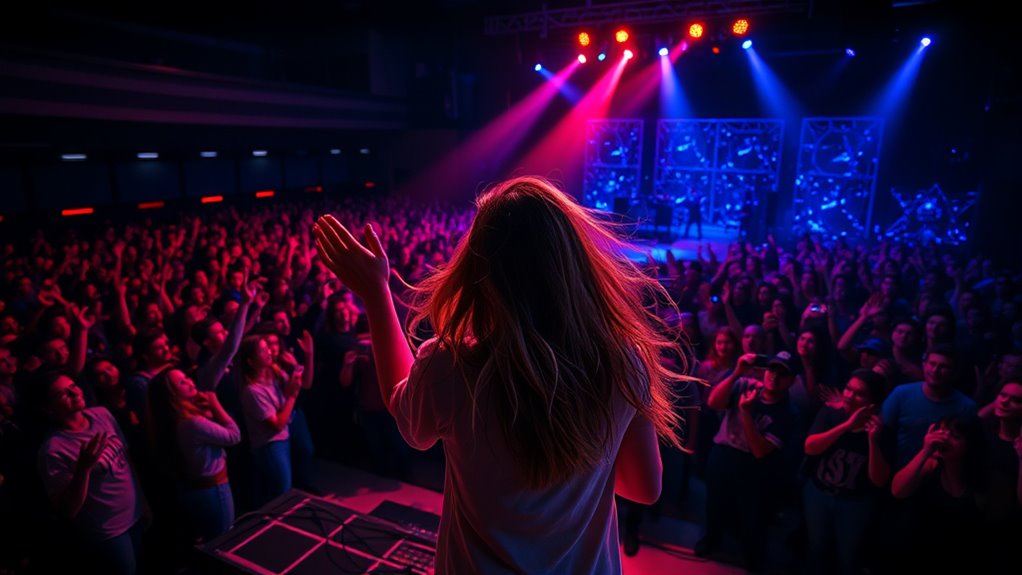Trailer bass drops work by using sound wave physics to create powerful low-frequency vibrations that tap into your primal instincts. When carefully timed with visual cues, these surges heighten your emotional responses and build anticipation. The deep rumble and sudden surge of bass stimulate your senses, making moments feel intense and unforgettable. By understanding how sound design manipulates your subconscious, you can see how these techniques craft emotionally impactful experiences—if you keep exploring, you’ll discover even more about this fascinating process.
Key Takeaways
- Bass drops utilize low-frequency sound waves to evoke primal, visceral emotional responses in audiences.
- Precise timing and volume control amplify suspense and heighten emotional tension before the drop.
- Synchronizing visual effects with bass surges enhances multisensory engagement and emotional impact.
- Sound design leverages physics principles of vibrations to influence subconscious feelings like excitement or fear.
- AI-driven sound analysis refines bass drop techniques to maximize audience emotional reactions effectively.

The science behind trailer bass drops reveals how sound design and physics combine to create intense emotional moments that grab your attention. When you experience a bass drop in a trailer, it’s not just about loud noise; it’s a carefully crafted event rooted in sound wave mechanics. Sound waves, which are vibrations traveling through the air, are manipulated to produce specific frequencies and amplitudes that evoke visceral reactions. As the bass builds, the sound waves grow in intensity, reaching a peak just before the drop. This buildup creates anticipation, priming your brain to respond emotionally. When the drop hits, the sudden surge of low-frequency vibrations stimulates your auditory system and triggers a flood of adrenaline, making you feel exhilarated, tense, or even fearful. Understanding these sound wave mechanics helps explain why certain bass drops generate such powerful emotional responses.
You can think of this process as an emotional impact analysis, where sound designers intentionally engineer the soundscape to maximize psychological effects. By analyzing how different frequency ranges influence mood, they craft bass drops that resonate with your subconscious. For example, lower frequencies tend to feel more primal and grounding, making the drop feel visceral and impactful. The timing and volume of these drops are meticulously calibrated to align with the narrative tension of the trailer, enhancing the emotional arc and heightening your engagement. When you hear that deep rumble, it’s not accidental; it’s a strategic tool meant to amplify your emotional connection to the story.
Moreover, the physical properties of sound waves work in tandem with visual cues to intensify your experience. The synchronization of a visual explosion with a bass drop creates a multisensory effect that amplifies your emotional response. Your brain associates the low-frequency vibrations with danger or excitement, intensifying feelings of anticipation or thrill. Skilled sound designers analyze audience reactions through emotional impact analysis, refining their techniques to evoke specific sentiments—be it awe, suspense, or adrenaline. Recent advancements in AI-powered sound analysis enable designers to optimize these effects further by predicting audience responses and tailoring sound design accordingly. By manipulating sound wave mechanics with precision, they guide your emotions, making the trailer unforgettable.
In essence, the science of trailer bass drops is about understanding how sound influences emotion. You may not realize it, but every deep rumble and sudden bass surge is a calculated move designed to tap into your primal instincts and heighten your emotional state. This blend of physics and psychology results in the powerful cinematic moments you can’t forget, proving that sound design is just as *vital* as visuals in storytelling.
Frequently Asked Questions
How Do Trailer Bass Drops Influence Viewer Memory Retention?
Trailer bass drops grab your attention, making you more likely to remember key moments. They enhance neural encoding by creating a strong sensory stimulus, which helps your brain store the information more effectively. However, if overused, sensory adaptation can occur, dulling the impact of future drops. So, well-placed bass drops boost your memory retention by engaging your senses intensely without overwhelming them.
Can Individual Hearing Sensitivity Affect Emotional Response to Bass Drops?
Imagine your hearing acuity as a finely tuned instrument, capable of amplifying or softening sounds. Your emotional sensitivity shapes how you respond to bass drops, making them feel more intense or subdued. If your hearing is highly sensitive, you might experience stronger emotional reactions, while lower sensitivity could dull the impact. So, individual hearing sensitivity definitely influences how you emotionally connect to bass drops.
What Role Does Cultural Background Play in Interpreting Bass-Heavy Trailers?
You might find that your cultural background influences how you interpret bass-heavy trailers. Cultural symbolism shapes your emotional response, making certain sounds feel more intense or familiar. Your genre perception also plays a role; if you’re used to action or horror films, you may respond more strongly to bass drops. These factors combine to personalize your experience, affecting how you perceive and react to the trailer’s emotional cues.
Are There Differences in Bass Drop Effectiveness Across Genres?
You’ll notice that bass drop effectiveness varies across genres due to genre variations and listener preferences. For example, action trailers often use powerful bass to excite viewers, while dramas might employ subtler drops to evoke emotion. Your response to bass drops depends on these genre-specific cues and your personal tastes, making some drops more impactful in certain contexts. Understanding these differences helps you better appreciate how trailers target your emotional reactions.
How Do Trailer Bass Drops Affect Audience Physiological Responses?
Imagine your heartbeat racing as a trailer’s bass drop hits—your body responds with neural activation and emotional arousal. These powerful sounds trigger your brain’s emotional centers, heightening excitement or tension. You feel your pulse quicken, muscles tighten, and adrenaline surge, making the experience more immersive. Bass drops actively shape your physiological responses, amplifying the trailer’s impact by engaging your nervous system and deepening your emotional connection.
Conclusion
By understanding how trailer bass drops trigger emotional responses, you can craft more powerful moments. Imagine you’re editing a suspenseful film trailer; timing a bass drop right before a shocking reveal can send chills through viewers. For example, a recent blockbuster used a well-timed bass drop to amplify the tension, making the climax unforgettable. When you harness this science, your trailers become more engaging, leaving audiences enthusiastic to experience the full story.









